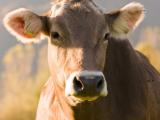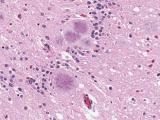Jan 27, 2004 (CIDRAP News) In response to the discovery of bovine spongiform encephalopathy (BSE) in a US cow last month, the Food and Drug Administration (FDA) yesterday announced a lengthy set of new rules to shield FDA-regulated foods and food supplements from BSE-contaminated material.
The rules include a ban on feeding mammalian blood to calves and a ban on the use of downer cattle and high-risk cattle tissues such as the brain and spinal cord in FDA-regulated products. In addition, the FDA is prohibiting the feeding of poultry litter and restaurant scraps to cattle and the use of "mechanically separated" beef in food.
The US Department of Agriculture (USDA), which regulates meat, poultry, and egg products, on Dec 30 banned the processing of downer cattlethose too sick or injured to stand at the time of slaughterfor food. The FDA regulates all other foods, including processed foods that contain meat, such as soups and pizza, along with food supplements and cosmetics.
In announcing the rules yesterday, Secretary of Health and Human Services (HHS) Tommy Thompson said they will add to a set of five existing "firewalls" protecting the public from BSE contamination. "Small as the risk may already be, this is the time to make sure the public is protected to the greatest extent possible," he said in a news release.
Cattle contract BSE by eating feed containing material from other infected cattle. Eating meat products from infected cattle is believed to be the cause of variant Creutzfeldt-Jakob disease (vCJD), a human neurologic disease similar to BSE.
The new FDA rules will take effect when they are published in the Federal Register, but public comments will be invited after publication, the agency said.
The FDA rules ban the following items from the foods, supplements, and cosmetic products it regulates:
- Any material from downer cattle or dead cattle (cattle that die before reaching a slaughter plant)
- Specified risk materials (SRMs), or high-risk tissues, which include the brain, skull, eyes, and spinal cord of cattle 30 months or older and the tonsils and part of the small intestine from all cattle
- Mechanically separated beef, which may contain high-risk tissues, but not beef from advanced meat recovery (AMR) systems. Mechanically separated beef may contain crushed or ground bones, while AMR systems separate meat without breaking bones. USDA rules bar SRMs from AMR-produced products.
The ban on feeding mammalian blood to calves closes a loophole in the FDA's 1997 ban on feeding parts from cattle and other ruminant animals to ruminants, HHS said. Under the 1997 rule, blood and blood products could still be fed to ruminants, and cattle blood is currently fed to calves as a milk replacement in some cases.
"Recent scientific evidence suggests that blood can carry some infectivity for BSE," the announcement said. That might have been a reference to a recent report from Britain of a person who contracted vCJD several years after receiving blood from someone else who was found to have the same disease.
The FDA is banning the use of poultry litter in cattle feed because it may contain spilled poultry feed that includes cattle parts, officials said. Poultry litter consists of bedding, spilled feed, feathers, and waste collected from poultry sheds. It is used in cattle feed in some areas where cattle and large poultry operations are close together, the FDA said. Cattle parts can legally be used in feed for poultry and hogs.
The new rule banning restaurant "plate waste" in cattle feed is intended to protect the FDA's ability to enforce the ban on using cattle parts in cattle feed, the FDA said. Plate waste includes meat scraps, which are collected from some restaurants for use in feed. Its presence "confounds" the FDA's ability to detect prohibited proteins in cattle feed, officials said.
The FDA also said it will require feed plants to use separate production equipment to make feed for nonruminant animals (such as poultry and hogs) if the feed contains proteins banned from cattle feed. Currently, some equipment is used to process both banned and permitted materials, which can lead to cross-contamination of cattle feed with banned materials.
The FDA also promised to step up its inspections of feed mills and rendering plants this year. The agency said it will inspect 2,800 plants and will fund another 3,100 inspections by state agencies. Officials said their goal is to inspect all known renderers and feed mills that process products containing materials banned from cattle feed.
See also:
FDA news release
http://archive.hhs.gov/news/press/2004pres/20040126.html


















